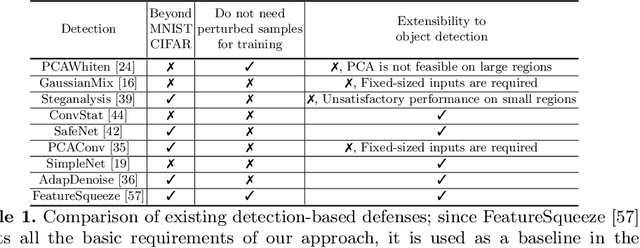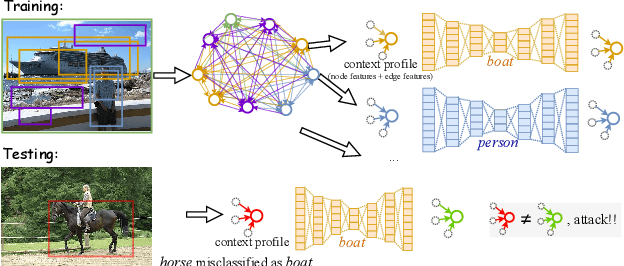Kevin S Chan
Connecting the Dots: Detecting Adversarial Perturbations Using Context Inconsistency
Jul 24, 2020



Abstract:There has been a recent surge in research on adversarial perturbations that defeat Deep Neural Networks (DNNs) in machine vision; most of these perturbation-based attacks target object classifiers. Inspired by the observation that humans are able to recognize objects that appear out of place in a scene or along with other unlikely objects, we augment the DNN with a system that learns context consistency rules during training and checks for the violations of the same during testing. Our approach builds a set of auto-encoders, one for each object class, appropriately trained so as to output a discrepancy between the input and output if an added adversarial perturbation violates context consistency rules. Experiments on PASCAL VOC and MS COCO show that our method effectively detects various adversarial attacks and achieves high ROC-AUC (over 0.95 in most cases); this corresponds to over 20% improvement over a state-of-the-art context-agnostic method.
Geometric Laplacian Eigenmap Embedding
May 23, 2019



Abstract:Graph embedding seeks to build a low-dimensional representation of a graph G. This low-dimensional representation is then used for various downstream tasks. One popular approach is Laplacian Eigenmaps, which constructs a graph embedding based on the spectral properties of the Laplacian matrix of G. The intuition behind it, and many other embedding techniques, is that the embedding of a graph must respect node similarity: similar nodes must have embeddings that are close to one another. Here, we dispose of this distance-minimization assumption. Instead, we use the Laplacian matrix to find an embedding with geometric properties instead of spectral ones, by leveraging the so-called simplex geometry of G. We introduce a new approach, Geometric Laplacian Eigenmap Embedding (or GLEE for short), and demonstrate that it outperforms various other techniques (including Laplacian Eigenmaps) in the tasks of graph reconstruction and link prediction.
Robust Coreset Construction for Distributed Machine Learning
Apr 11, 2019



Abstract:Motivated by the need of solving machine learning problems over distributed datasets, we explore the use of coreset to reduce the communication overhead. Coreset is a summary of the original dataset in the form of a small weighted set in the same sample space. Compared to other data summaries, coreset has the advantage that it can be used as a proxy of the original dataset, potentially for different applications. However, existing coreset construction algorithms are each tailor-made for a specific machine learning problem. Thus, to solve different machine learning problems, one has to collect coresets of different types, defeating the purpose of saving communication overhead. We resolve this dilemma by developing coreset construction algorithms based on k-means/median clustering, that give a provably good approximation for a broad range of machine learning problems with sufficiently continuous cost functions. Through evaluations on diverse datasets and machine learning problems, we verify the robust performance of the proposed algorithms.
 Add to Chrome
Add to Chrome Add to Firefox
Add to Firefox Add to Edge
Add to Edge